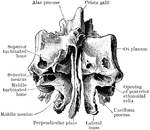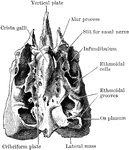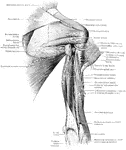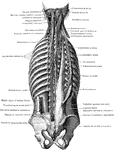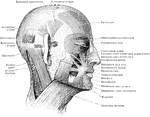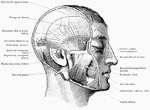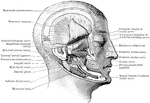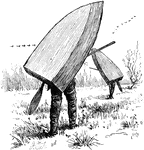
Front of the Skull
Shown is norma frontalis, which refers to the front of the skull. Labels: 1, mental protuberance; 2,…
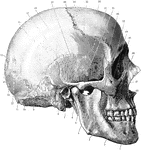
Side of the Skull
Shown is norma lateralis, which refers to the side of the skull. Labels: 1, mental foramen; 2, body…

Base of the Skull
Shown is norma basalis, which refers to the base of the cranium. Labels: 1, external occipital crest;…
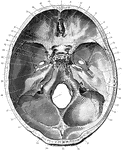
Base of the Skull Seen From Above
Shown is the base of the skull seen from above. Labels: 1, frontal bone; 2, slit for nasal nerve; 3,…
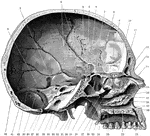
Skull Seen From Side
Shown is the inner aspect of the left half of the skull sagittally divided. Labels: 1, suture between…

Coronal Section of Skull
Shown is a coronal section passing inferiorly through interval between between the first and second…

Codeso del Pico
"Adenocarpus frankenioides. 1. the standard, wings, and keel split open; 2. the stamens; 3. a cross…
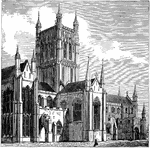
Worcester Cathedral
The Cathedral was founded in 680 with Bishop Bosel as its head. The first cathedral was built in this…

Mitre and Crosier
The mitre is a type of headgear now known as the traditional, ceremonial head-dress of bishops and certain…
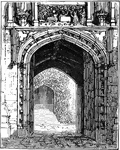
Gate of Merton College, Oxford
Merton College is one of the constituent colleges of the University of Oxford in England. Its foundation…

Cornucopia
An illustration of a cornucopia which is also know as a horn 'o' plenty. The cornucopia is a symbol…
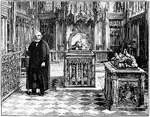
Beauchamp Chantry, St. Mary's, Warwick
The church foundations date back nearly nine hundred years, being created by Roger de Beaumont, 2nd…
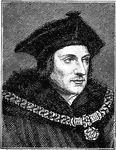
Sir Thomas More
Sir Thomas More (7 February 1478 – 6 July 1535), from 1935 Saint Thomas More, was an English lawyer,…

Sir Thomas More's House, Chelsea
Sir Thomas More (7 February 1478 – 6 July 1535), from 1935 Saint Thomas More, was an English lawyer,…
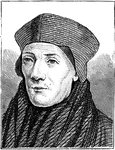
John Cardinal Fisher
John Cardinal Fisher (c.1469 – 22 June 1535), from 1935 Saint John Fisher, was an English Catholic…

Astragalus
The right astragalus. A, Upper surface. B, Under surface. Labels: 1, groove for flex, long, hallucis;…

Astragalus
The right astragalus. A, As seen from the outer side. B, As seen from the inner side. Labels: 1, external…

Bust of Man
A bust is a sculpted or cast representation of the upper part of the human figure, depicting a person's…
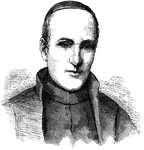
Peter Jan Beckx
Peter Jan Beckx (February 8, 1795, Sichem, Belgium - March 4, 1887, Rome, Italy) was a Belgian Jesuit,…
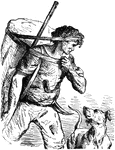
Man Hunting
An illustration of a man carrying a container with his rifle on his back and with a large knife in his…

Head Showing Deep Mastication Muscles
A deep view of the muscles of mastication. The zygoma and masseter muscle are removed.
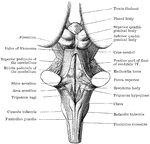
Back View of Medulla, Pons, and Mesencephalon
Back view of the medulla, pons, and mesencephalon of a full term human fetus.

Dogwood
"Benthamia japonica. 1. a flower; 2. a perpendicular section of the pistil; 3. a head of fruit; 4. a…

Butttonbush
"Brunia japonica. 1. a flower; 2. a perpendicular section of the pistil; 3. a head of fruit; 4. a section…
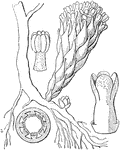
Cytinus
"Cytinus Hypocistis. 1. A flower; 2. a head of anthers; 3. a transverse section of the ovary." -Lindley,…

Centrolepis
"Centrolepis fascicularis. 1. A head of flowers; 2. a single flower separated; 3. an ovary with the…

Distribution of Cutaneous Nerves on the Back
The distribution of the cutaneous nerves on the back of the trunk. On one side the distribution of the…
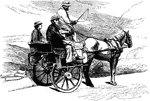
Jaunting Car
The Irish form of the sprung cart, called a jaunting car or jaunty car, was a light, horse-drawn, two-wheeled…

Brown Pelican and Sea Gull
An illustration of a brown pelican with a fish in it's mouth and a sea gull resting on his back. The…
Cutaneous Nerves of the Back Legs
Distribution of cutaneous nerves on the back of the lower legs. On the one side the distribution of…
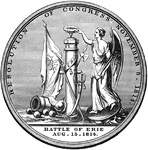
General Gaines's Medal
General Edmund Pendleton Gaines was awarded the Thanks of Congress, an Act of Congress Gold…
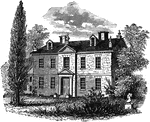
Chew's House
Benjamin Chew (November 19, 1722 – January 20, 1810) was a fifth-generation American, a Quaker-born…

Roman Coins (Denarius)
An illustration of a roman coin (denarius). The left side represents the laurel-crowned head of Titus.…

Aztec Imitation of Ganesha - Elephant-faced god
An Aztec sculpture of an elephant-faced god, supposedly an imitation of the Hindu god, Ganesha.
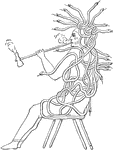
Atatarho
Atotarho is a historical figure for whom there is almost no historical record. Oral tradition stories…

Cross-Section of a Grenade
Instead of a standard bouchon assembly being used this grenade is equipped with a Percussion Plug Assembly,…

Buffer Mechanism
The buffer consists of a tube in which are placed successively from front to rear, the buffer head,…

Guillotine
The guillotine was a device used for carrying out executions by decapitation. It consists of a tall…
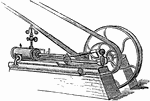
Steam Engine
A steam engine is a heat engine that performs mechanical work using steam as its working fluid. Steam…
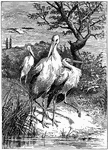
Egrets
An egret is any of several herons, most of which are white or buff, and several of which develop fine…
